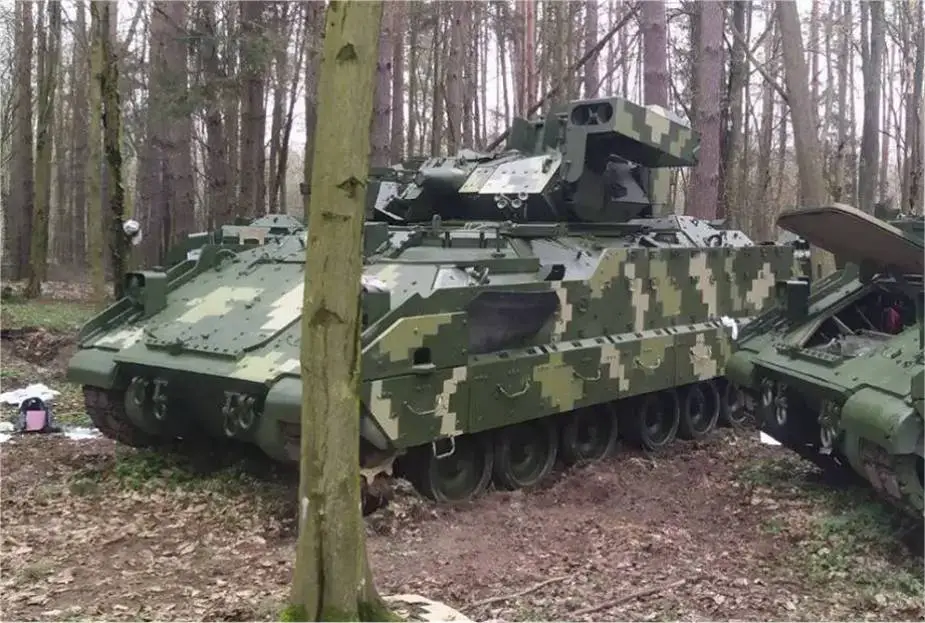- Army
- Conflicts in the world
- Israel - Iran conflict 2025
- Pakistan - India Conflict 2025
- Russia Ukraine War 2022
- Libya conflict day by day
- HAMAS - Israel War 2023
- Operation Serval in Mali French Army
- Sangaris operation Central African Republic
- Sangaris opération militaire République Centreafrique
- Ukraine - Russia conflict
- Syria conflict news
- Defence & Security Industry Technology
- Armies in the world
- Analysis Defense and Security Industry
- Conflicts in the world
- Navy
- Air
Ukrainian Forces Use US Bradley M2A2 IFVs & Leopard 2A6 Tanks in Counteroffensive against Russian Forces
According to a video published on Telegram on July 23, 2023, finally, the Ukrainian army use conventional military tactics using American Bradley M2A2 tracked armored IFV Infantry Fighting Vehicles with Leopard 2A6 Main Battle Tanks (MBTs) in a counteroffensive against Russian positions near the city of Zaporizhzhia, in southeast Ukraine. As a former NCO (Non-Commissioned Officer) in an infantry mechanized battalion and CEO of Army Recognition Group, I explain in this article, the underlying principle of most modern military tactics which is a concept known as combined arms.
Follow Army Recognition on Google News at this link

Ukrainian army deploys U.S. Bradley M2A2 IFVs and German Leopard 2A6 tanks to conduct a counteroffensive operation near the city of Zaporizhzhia, in southeast Ukraine.(Picture source ScreenShot Telegram video)
This involves using different types of forces together to provide mutual support and compensate for each other's vulnerabilities. When we speak of infantry, infantry fighting vehicles (IFVs), and main battle tanks (MBTs), combined arms doctrine is absolutely central.
Let's take an example of an armored battalion consisting of MBTs and IFVs, supported by infantry. Main Battle Tanks, with their heavy armor and powerful cannons, are very effective against enemy armored forces and fortifications. However, they can be vulnerable to close-quarters attacks in urban or heavily forested environments, or from anti-tank guided missiles (ATGMs).
That's where Infantry and IFVs come into the picture. Infantry Fighting Vehicles, which are essentially armored vehicles designed to carry and support infantry, can provide the flexibility that the MBTs lack. They are typically lighter, more maneuverable, and can navigate more easily in complex terrains. Their armament, often consisting of a combination of machine guns, automatic cannons, and sometimes anti-tank missiles, can engage a wide range of targets. The dismounted infantry can clear out buildings or forests, dealing with threats that are difficult for the more heavily armored vehicles to handle.
The idea behind these deployments is to balance the strengths of each type of unit against the weaknesses of the others. For instance, while a portion of the force is engaging the enemy and keeping them suppressed (often referred to as "winning the firefight"), another part of the force can maneuver to advantageous positions. This fundamental tactic, known as fire and movement, can be executed in many different ways depending on the specific situation.
All these aspects of coordination, balance, and mutual support are integral to modern warfare. However, it is worth noting that the specifics can vary widely based on factors like terrain, the nature of the enemy, the mission at hand, and the specific doctrines and capabilities of the force in question. Military tactics are also continually evolving, driven by advancements in technology, lessons from past conflicts, and shifts in strategic thinking.

The United States has supplied Ukraine with 186 Bradley M2A2 IFVS Infantry Fighting Vehicles. (Picture source Social Network)
In this case, the Ukrainian army's use of American Bradley M2A2 IFVs (Infantry Fighting Vehicles) and German Leopard 2A6 Main Battle Tanks (MBTs) is a classic example of combined arms tactics in a modern context, particularly when operating in environments where the threat of mines, RPGs (Rocket Propelled Grenades), and ATGMs (Anti-Tank Guided Missiles) is high.
Today, the United States has already supplied Ukraine, with 186 Bradley M2A2 tracked armored IFVs (Infantry Fighting Vehicles) while Germany has delivered 18 Leopard 2A6 tanks.
The M2A2 Bradley is a highly versatile IFV designed for transporting, supporting, and coordinating with infantry units. It's equipped with a 25mm autocannon, TOW anti-tank missiles, and a 7.62mm machine gun, enabling it to engage a variety of enemy targets. Additionally, its advanced armor protection allows it to resist small arms fire and shrapnel, and it also has some level of protection against heavier anti-armor threats.
On the other hand, the Leopard 2A6 is one of the most advanced MBTs in the world, renowned for its excellent combination of firepower, protection, and mobility. It has a powerful 120mm smoothbore gun, capable of defeating most contemporary armored threats. Its advanced modular armor provides robust protection against a range of anti-tank weapons.
In a typical combined arms operation, these two vehicles would work closely together along with dismounted infantry. The infantry, supported by the Bradleys, would advance carefully, scanning for enemy threats and clearing out obstacles. If they encountered an enemy position or an armored threat, they could call on the Leopard tanks or the Bradley's TOW missiles to provide heavy fire support.
The tanks and IFVs also provide a crucial overwatch function. If the infantry comes under fire, they can retreat to the relative safety of the armored vehicles, which can then suppress the enemy with their heavier weapons.
With regards to protection from mines, RPGs, and anti-tank missiles, the vehicles' armor plays a crucial role. Modern military vehicles often feature modular armor that can be upgraded to deal with specific threats, reactive armor to defeat anti-tank warheads, and a variety of active protection systems that can detect and intercept incoming projectiles. In some cases, specialized mine-resistant vehicles or sapper teams may be deployed ahead of the main force to clear potential threats.
News Russia Ukraine War


























